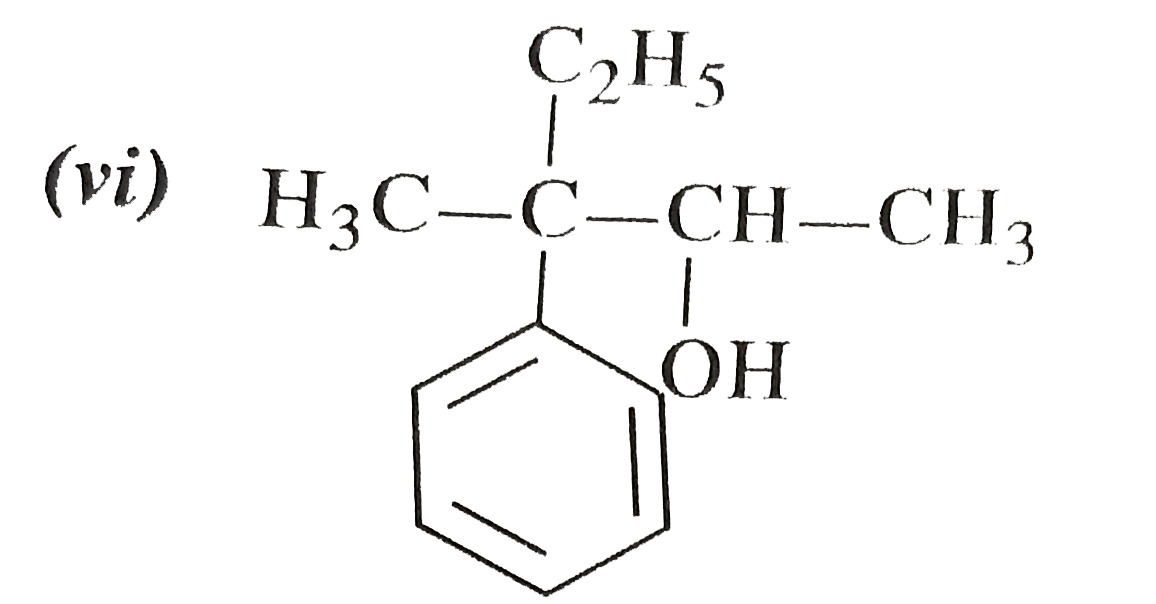How do you distinguish between CH3CH=CHCl,CH3CH2CH2ClandCH2=CH−CH2Cl ?Solution in Telugu
The Cl in CH2=CHCH2Cl is very reactive. This reacts rapidly with AgNO3 in the cold to give a white precipitate of AgCl. CH3CH2CH2Cl gives white precipitate when warmed with AgNO3 as it is comparatively less reactive. CH3CH=CHCl is inert and does not form white precipitate with AgNO3
Topper's Solved these Questions
- BOOK - AAKASH SERIESCHAPTER - ALKYL AND ARYL HALIDESEXERCISE - Exercise-1.1.16videos
ALKYL AND ARYL HALIDES
- BOOK - AAKASH SERIESCHAPTER - ALKYL AND ARYL HALIDESEXERCISE - Exercise-1.1.214videos
ALKYL AND ARYL HALIDES
- BOOK - AAKASH SERIESCHAPTER - ALKYL AND ARYL HALIDESEXERCISE - PRACTICE EXERCISE52videos
ALKYL AND ARYL HALIDES
- BOOK - AAKASH SERIESCHAPTER - ALDEHYDES AND KETONESEXERCISE - Exercise 3.241videos
ALDEHYDES AND KETONES
- BOOK - AAKASH SERIESCHAPTER - AMINES AND AZO COMPOUNDS EXERCISE - PRACTICE SHEET - 6 (Integer answer type Questions)9videos
AMINES AND AZO COMPOUNDS
Similar Questions
What are geminal dihalides and vicinal dihalides ? Give examples.
05:48View SolutionExplain the preparation of ethyl chloride from (i) ethyl alcohol, (ii) ethylene and (iii) ehane
01:17View SolutionNumber of possible isomers with the molecular formula C3H9Cl is
View SolutionGive the IUPAC names of the following compounds: (CH3)3CCH2CHO,CH3CH=CHCHO,CH3CH2COCH(C2H5)CH2CH2ClandCH3CH(OH)CH2COCH3
04:47View SolutionHow many aromatic (six membered carbocyclic) isomers possible for MFC7H9N.
03:44View SolutionGiven the IUPAC names of the following compounds: (i) CH_(3)CH_(2)CH_(2)underset(C_(2)H_(5))underset(|)overset(CH_(3))underset(|)(C )CH_(2)-overset(CH_(3))overset(|)(C )=CH_(2) (ii) CH_(3)-overset(CH_(3))overset(C )H-C-=CH (iii) C_(6)H_(5)-CH=CH-CH_(2)Cl CH_(3)CH-CH-CH_(2)Cl (iv) CH_(3)CH=CH-CH_(2)Br v CH_(2)=CH-overset(Cl)overset(|)(C )-CH=CH_(2) vi CH_(2)=CH-overset(CH_(2)CH_(3))underset(|)(C )H-underset(Cl)underset(|)(C )=CH_(2) vii. (CH_(3))_(3)C - CH=CH_(2)
02:44View SolutionCH2CH2CH2−Cl and CH3−CH∣CH−CH3 shows which type isomerism
View SolutionGive the IUPAC names of the following compounds:
(i)C6H5−CH2−CH2−OH (ii)CH3−CH3∣C∣CH3−CH2−CH2−OH
(iii)[(CH3)2CH]3COH. (iv)CH3−CH∣OH−CH2−CH2−O−CH2CH3
(v)CH3−CH2−CH∣Cl−CH∣CH3−CH3∣C∣OH−CH3 (vi)
(vii)(CH3)3COH (viii)CH3−CH∣CH3−CH∣OH−CH2−CH∣CH3−CH3
(ix) CH2OH |CH2−CH2−CH−CH−CH−CH3 | | CH2Cl CH3, (x) CH3−C=C−CH2OH | | CH3Br
(xi) CH2=CH−CH∣OH−CH2−CH3, (xii) CH2OH |CH3−CH−CH2−CH−CH−CH3 | | CH3 OH06:10View SolutionGive the IUPAC names of the following compounds : (i) {:(" "CH_(2)OH),(" |"),(CH_(3)-CH_(2)-CH-CH-CH-CH_(3)),(" |"" |"),(" "CH_(2)Cl" "CH_(3)):} (ii) {:(" "CH_(2)OH),(" |"),(CH_(3)-CH-CH_(2)-CH-CH-CH_(3)),(" |"" |"),(" "CH_(3)" "OH):} (iii) H_(2)C=CH-underset(OH)underset(|)(CH)-CH_(2)-CH_(2)-CH_(3) (iv)
04:15View SolutionThe IUPAC name of the compound BrCH_(2)CHCl-underset(CH_(3)-CH_(2)-CH_(2))underset(|)(CH)-underset(CH_(2)-CH_(2)-CH_(3))underset(|)(CH)-CHBrCH_(2)Cl
View SolutionGive the order of reactivityh towards SN^(1) reaction of the following: i. ClCH_(2)CH = CH_(2) ii. CH_(3)CH_(2)CH_(2)Cl iii. CH_(3)CH = CHCl
01:19View SolutionCH3 ∣CH3−CH−CH−CH−CH2−CH2 | | CH2−ClCH3
locants at parent carbon chain will be :-02:59View Solutionनिम्नलिखित यौगिकों को SN1 क्रियाशीलता के बढ़ते हुए क्रम में व्यवस्थित कीजिए -
(a) ClCH2CH=CHCH2CH3,CH3C(Cl)=CHCH2CH3,CH3CH=CHCH2CH2Cl(b) CH3CH2Br,CH2=CHCH(Br)CH3,CH2=CHBr,CH3CH(Br)CH3(c) (CH3)3CCl,C6H5C(CH3)2Cl,(CH3)2CHCl,CH3CH2CH2Cl07:11View Solutionनिम्नलिखित यौगिकों के IUPAC नाम लिखिए-
(i) CH3 |CH3−CH2−CH−CH−C−CH3 | | | CH3 I CH3
(ii) Cl |CH3−CH2−CH−CH−C−CH3 | | | CH3 OH CH302:03View SolutionThe correct IUPAC name for CH_(3)-CH_(2)-O-overset(CH_(3))overset(|)(CH)-CH_(2)-CH_(2)-CH_(2)Cl is:
View Solution

